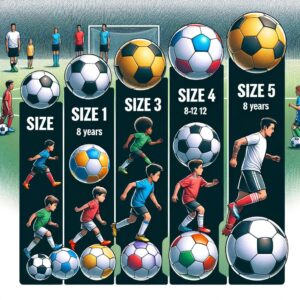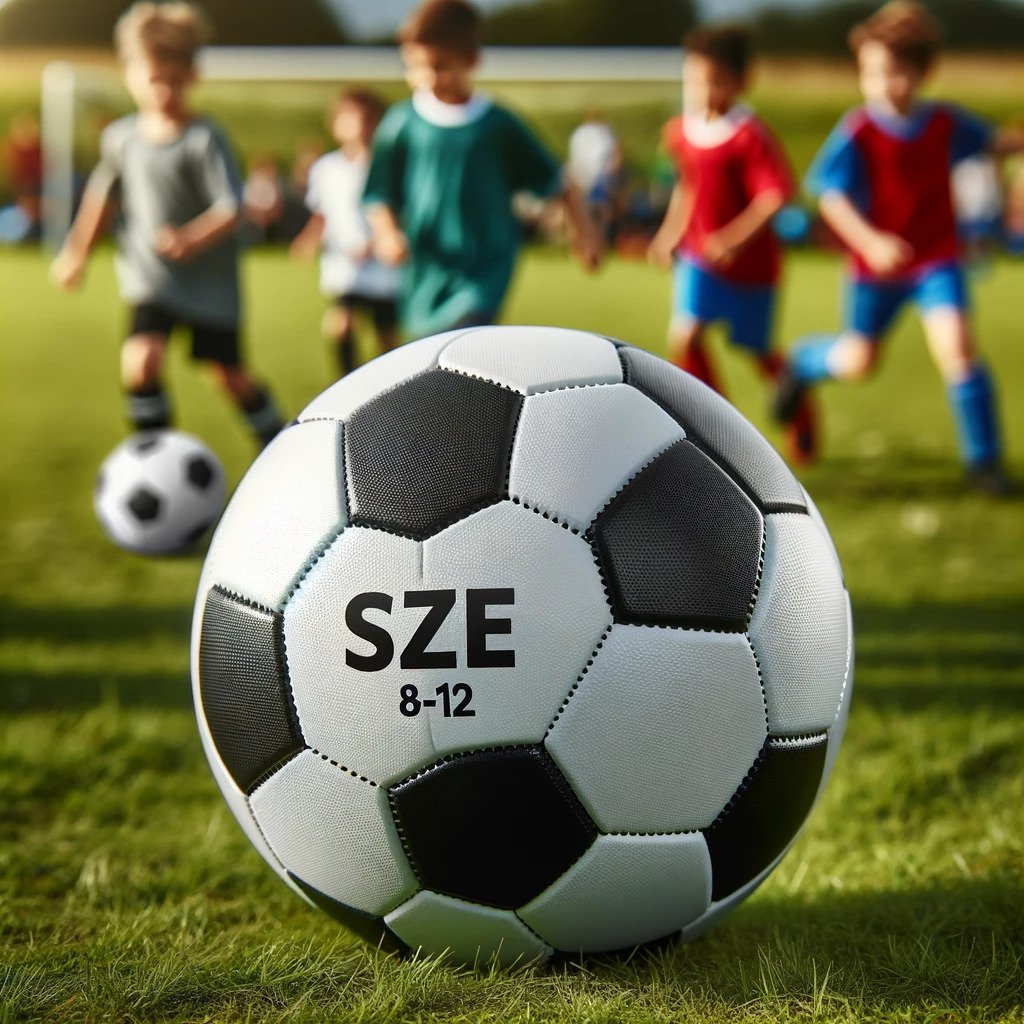As a parent and long-time soccer coach, I’ve observed how vital the right size of a soccer ball can be in the development of young athletes. The ball is, after all, the most significant piece of equipment in soccer. Choosing the appropriate ball for a child of a certain age is crucial, not just for their skill development but for their enjoyment of the game as well.
When it comes to soccer balls, there are many sizes, each designed for various age groups. For example, you wouldn’t want to use a size 2 ball for a child who should be playing with a size 4. This is especially true for youth players who are still mastering the basics of the game. Each size is tailored to suit the age group it’s intended for, ensuring that the ball is neither too heavy nor too cumbersome for the young players.
In my experience, the right ball can significantly enhance a child’s ability to learn and enjoy the game. This guide aims to cover these different ball sizes and teach you how to choose the best one for your budding soccer star.
Different Soccer Ball Sizes by Age
When purchasing a soccer ball, many shoppers may not fully know why the size of the ball is so crucial. It’s a common oversight; I didn’t know at first either. The truth is, the size of a soccer ball greatly matters, especially when considering the age and development stage of the player.
Soccer balls differ not just in size, but also in construction, shape, and height, each aspect tailored to suit different age groups. For parents and coaches, this lack of knowledge can easily lead people to buy the wrong ball. A size 4 ball, for instance, is designed for a specific age group, ensuring that it complements their physical abilities and enhances their playing experience.
From my experience in youth soccer coaching, choosing the right ball is not just about the game’s rules; it’s about fostering proper skill development and ensuring safety. Curious about the right age for a size 4 soccer ball? It’s typically perfect for children aged 8 to 12 years, balancing the right weight and size for their handling skills. Remember, the right ball can make a significant difference in a young athlete’s soccer journey.
Purpose behind Soccer Ball Sizes
When selecting a soccer ball for younger players, it’s essential to understand that not all balls are made equal. For instance, while you might need a ball for practice, it’s different from the one used in an official match. Practice balls are specifically made for practicing purposes only, designed to accommodate the needs of training sessions. They differ in characteristics such as air retention, form, water absorption, slope, and trajectory, compared to the more sophisticated match balls.
Moreover, similarly to how practice and match balls vary, there’s a difference in the construction and features of balls intended for different playing surfaces. Whether it’s indoor, pool, or street soccer, each type of ball is tailored to its environment. This specialization ensures that players can develop the right skills and techniques for each setting.
So, when choosing a size 4 ball, consider not just the age but also the purpose and playing surface to ensure optimal performance and skill development.
Why Size Matters?
Knowing the correct size of a soccer ball for a child is more than just a matter of preference; it’s essential. The size of the ball is necessary to ensure safety and proper skill development. A ball that’s not the right size can possibly lead to injury, especially in youth players. For instance, if a young player kicks a size five ball daily, which is made for adults, they are bound to sustain an injury due to the pressure and diameter of the ball.
Conversely, only adult players should use a size five ball. For younger players, it’s not just about escaping injuries; they might want a ball with the right bounce and weight for their required exercises.
Therefore, even professional soccer players, while they play with a size 5 on the pitch, they also train with different sizes for skill development. This tailored approach helps in honing specific skills and ensures the safety of the players across various age groups.
Different Soccer Ball Sizes

In the world of soccer, the size of the ball is as crucial as the game itself. For parents and coaches, understanding the different sizes of soccer balls is key to nurturing young talents. Each size is designed with a specific age group in mind, impacting everything from how a child learns to kick and control the ball to the development of their soccer skills.
Size 1: For the Youngest Players
Size 1 soccer balls, measuring 18 – 20 inches in circumference, are the smallest available. These are excellent for children aged 3 and under. They are perfect for toddlers just starting to walk and kick around a ball. Due to their smaller size and weight, they are less likely to break things in the house, making them a great choice for indoor play.
Interestingly, Size 1 balls are not just for kicking. They are also used by some people for technical training to improve touch and control due to their small size. Additionally, teams often use these balls to give away as souvenirs, adorned with player or club logos.
Size 2: A Step Up
Size 2 balls are slightly larger, measuring 20 – 22 inches in circumference and weighing 250-280 grams. They are the least standard size in youth soccer programs, often overlooked for size 3. However, they are recommended for toddlers and preschoolers, specifically those between 3 – 5 years old.
Besides young children, Size 2 balls also find a market with older players. They are used to practice skills, control, juggling, and tricks. Clubs often use this size for their promotional balls.
Size 3: Entering the Game
Size 3 balls, used by players aged 5 – 8 years old, mark the entry into more organized soccer. These balls are 23 – 24 inches in circumference and weigh between 300 – 320 grams. They are often the first soccer ball size used in real games and matches, especially in club and recreational leagues starting from U6.
The Size 3 ball is ideal for this age group. It’s larger and heavier than a Size 2 but still smaller and lighter than sizes 4 and 5, making it perfect for younger players. It encourages proper handling and control, helping players to gain confidence and develop their skill base.
Size 4: The Transitional Stage
The Size 4 soccer ball is tailored for youth players aged 8 – 12 years old. With a circumference of 25 – 26 inches and a weight of 350 – 390 grams, it’s slightly smaller and lighter than a Size 5 ball. This makes it easier to control and move during practices and matches, essential for players in this transitional age.
Size 5: For the Older Players
Finally, the Size 5 soccer ball, suited for ages 12 and older, including adults and professionals. It is the most commonly used size in soccer. With a circumference of 27 – 28 inches and a weight of 410 – 450 grams, it’s the heaviest of the sizes and not recommended for younger children. For official matches, Size 5 balls with the “FIFA Approved” or “FIFA Inspected” stamp are used, ensuring they meet the official size and weight requirements.
Size 4 Soccer Ball Age
The size 4 soccer ball, often referred to as a medium ball, is a crucial tool in the developmental journey of young soccer players. Designed for amateur games, it acts as a buffer between the small balls used by very young children and the huge balls used in professional play. This size, with a diameter of 25′′-26′′ and a weight of 350-390 grams, is primarily used by youth players aged 8 to 12. It’s perfectly suitable for this age range, providing a balance that helps young athletes become more comfortable with their skill sets.
Moreover, while children in this age group can technically play with a full-size professional soccer ball, such as a size 5, it can be quite challenging for them. In my opinion, the size 4 ball offers a reduction in size that doesn’t hinder the young players’ ability to continue to train and develop. It’s an optimal choice, ensuring that young players are not overwhelmed by the ball’s size and weight, allowing them to focus on improving their skills on the pitch.
What Size Soccer Ball is Right for Me?
When it comes to choosing the right soccer ball, one of the most obvious reasons to consider is the safety of the younger players. Sizing standards in soccer are not arbitrary; they are essential, especially for kids. For instance, a 4-year-old hit by a size 5 ball will likely hurt more than if hit by a size 3 ball. This is because kids are smaller, and thus, the balls should be proportionate to their size. The idea is to prevent injuries that can occur from a ball too large or too heavy for their age and physique.
Moreover, the size of the ball is essential for learning how to control it. Little kids with small feet will have trouble manipulating a ball that is too big for them. A size 5 ball is significantly heavier than a size 4 or size 3, which could cause injuries to muscles and tendons if a child tries kicking a ball that is too large for them.
Therefore, selecting the correct ball size is crucial, not just for the development of soccer skills but also for the physical well-being of young players.
Conclusion
The ideal age range for using a size 4 soccer ball is between 8 to 12 years old. This size provides a perfect balance for young players, being large enough to challenge and develop their skills, yet small enough to ensure safety and ease of control.
As children grow and improve in their soccer journey, it’s important to equip them with the right tools, and choosing the appropriate soccer ball size is a key part of this process. The size 4 ball serves as an excellent transition from junior to more advanced play, supporting the development of young athletes as they prepare for the next level of the game.
Frequently Asked Questions
-
What does size 4 soccer ball mean?
A size 4 soccer ball is designed for youth players, typically aged between 8 to 12 years old. It’s smaller in size and lighter in weight compared to adult balls, making it suitable for the physical capabilities and skill development of children in this age range.
-
What size soccer ball for a 7 year old boy?
For a 7 year old boy, a size 3 soccer ball is recommended. This size is appropriate for children aged 5 to 8 years old, as it matches their size, strength, and skill level.
-
How do you size a soccer ball?
Soccer balls are sized based on their circumference. Sizes range from 1 to 5, with size 1 being the smallest and size 5 being the standard adult size. The size is chosen based on the age and skill level of the players.
-
How many cm is a size 5 football?
A size 5 football, the standard size used by adults and professional players, has a circumference of about 68 to 70 cm.
-
What size soccer ball for a 12 year old boy?
A 12 year old boy should use a size 4 soccer ball. This size is typically used by youth players aged 8 to 12 years and helps in skill development and transition to larger balls.
-
What size soccer ball for 4th grade girls?
For 4th grade girls, generally around 9 to 10 years old, a size 4 soccer ball is ideal. It’s suitable for their physical development and skill level at this age.
-
What size soccer ball for high school girls?
High school girls typically use a size 5 soccer ball, the same size used in adult and professional matches. This size is suitable for players aged 12 years and older.

